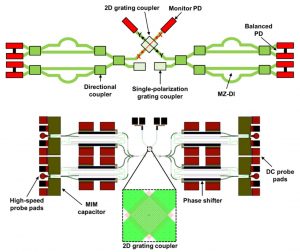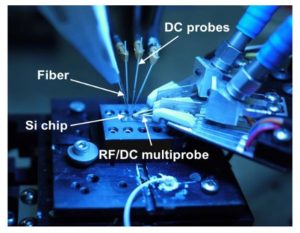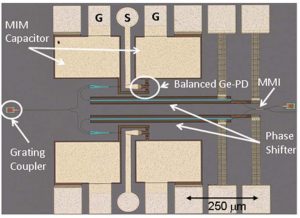In addition to the intensity, information can be encoded on the phase, frequency, and polarization of an electromagnetic wave to carry information. Advanced modulation formats utilize a combination of these properties to increase the data carrying capacity of transmission channels. Corresponding transmitters and receivers require many functions such as intensity modulators, phase modulators, phase shifters, optical hybrids, balanced photodetectors, delay lines, and polarization control elements. Integrated photonics is therefore an ideal candidate for incorporating these functions in a compact form factor on a single chip. In addition to impacting communication systems in long-haul, metro, and free space networks, these transceivers, including coherent implementations, are expected to impact data center networks in the near future.



Selected Relevant Publications:
- “A 100-Gb/s Noncoherent Silicon Receiver for PDM-DBPSK/DQPSK Signals,” Optics Express, vol. 22, no. 2, 2014.
- “InP monolithically integrated coherent transmitter,” Optics Express, vol. 23, no. 8, pp. 10741-10746, 2015.
- “Integrated Reconfigurable Coherent Transmitter Driven by Binary Signals,” IEEE Journal of Selected Topics in Quantum Electronics, vol. 21, no. 6, 2015.
- “A Compact Silicon Coherent Receiver Without Waveguide Crossing,” Photonics Journal, vol. 7, no. 4, 2015.
- “Ultra-compact 56-Gb/s QPSK and 80-Gb/s 16-QAM silicon coherent receiver free of waveguide crossings,” Group IV Photonics Conference (GFP), 2014.
- “A silicon receiver for 100 Gb/s PDM-DQPSK signals,” OptoElectronics and Communications Conference (OECC)/Photonics in Switching (PS), 2013.
- “Versatile low-complex 16-QAM optical transmitter driven by binary signals,” IEEE Globecom Workshops, 2012.
- “Versatile offset-free 16-QAM single dual-drive IQ modulator driven by binary signals,” Optics Letters, vol. 37, no. 19, pp. 4149-4151, 2012.
Collaborators: Scuola Superiore Sant’Anna, CNIT, Ericsson